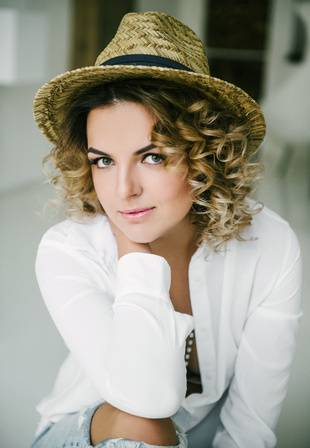Photography is, first of all, practice. Moreover, it is necessary when shooting female portraits. The ability to immediately grasp the character, essence, look, emphasize the mood and transfer it to the picture is gained only by experience. And, most importantly, a female portrait is a huge field for the photographer to express herself as an artist. Indeed, through the prism of female nature, one can talk about weakness and strength, about peace and war, about love and pain. Tip 1: Take your camera and start shooting. Any camera is ready to help you when shooting portraits: with a crop matrix and full-frame, mirrorless and mirror. Start taking pictures, do not justify your inaction by the absence of some special lens for shooting portraits. Any lens will do, especially if you are a beginner photographer. With experience, you will understand which optics are closer and more convenient to you, what its functions are necessary for you. I shoot on Nikon D700 and Nikon D800, lenses AF-S NIKKOR 24-70mm f / 2.8G ED, AF-S NIKKOR 50mm f / 1.8G, AF-S NIKKOR 70-200mm f / 2.8G ED VR II. And all three lenses are great companions in portrait photography. For a novice in photography, one lens is enough to take portraits. So, for a full-frame camera, Nikon AF-S NIKKOR 50mm f / 1.8G or Nikon AF-S NIKKOR 50mm f / 1.4G are suitable. As you grow professionally and creatively, you can purchase a top-end fixed-focus lens, such as the Nikon AF-S NIKKOR 85mm f / 1.8G or AF-S NIKKOR 105mm f / 1.4E ED. If you want something more versatile to move around the set less, consider optionszoom lenses . For example, Nikon AF-S NIKKOR 24-70mm f / 2.8G ED. With this lens you can not only create portraits, but also shoot reports.
10 tips for creating a female portrait

NIKON D800 / 24.0-70.0 mm f / 2.8 Installations: ISO 800, F2.8, 1/200 s, 70.0 mm equiv.
NIKON D800 / 24.0-70.0 mm f / 2.8 Installations: ISO 800, F2.8, 1/200 s, 45.0 mm equiv.
NIKON D800 / 24.0-70.0 mm f / 2.8 Installations: ISO 100, F5.6, 1/250 s, 70.0 mm equiv.
Tip 3: Don't be afraid to open the diaphragm. This gives a significant advantage when shooting a portrait. You separate the background, focusing on the person. Moreover, the farther away from the background the model is, the stronger the blur will be with an open aperture. Open the aperture based on the capabilities of your lens. If you have an AF-S NIKKOR 50mm f / 1.8G or AF-S NIKKOR 50mm f / 1.4G, then you can safely open up to 1.8–1.4, most importantly, do not miss the focus.
NIKON D800 / 24.0-70.0 mm f / 2.8 Installations: ISO 200, F5.6, 1/200 s, 70.0 mm equiv.
Tip 4: Focus the camera on the eyes of the model. Eyes are the most important component of a photo portrait, as they express the emotional state of the model. To prevent autofocus from letting you down, use manual focus on the eyes. If both eyes do not fall into focus, for example, when the model is half-turned towards the camera, then focus on the nearest one. And so that there is no blurry image, remember that for shooting a person it is better to keep the shutter speed at least 1/200, 1/250.
NIKON D800 / 50.0 mm f / 1.8 Settings: ISO 640, F2.5, 1/500 s, 50.0 mm equiv.
NIKON D700 / 50.0 mm f / 1.8 Installations: ISO 200, F4, 1/400 s, 50.0 mm equiv.
NIKON D800 / 24.0-70.0 mm f / 2.8 Installations: ISO 320, F4.5, 1/200 s, 70.0 mm equiv.
NIKON D800 / 24.0-70.0 mm f / 2.8 Installations: ISO 160, F4.5, 1/200 s, 70.0 mm equiv.
NIKON D800 / 24.0-70.0 mm f / 2.8 Installations: ISO 640, F2.8, 1/250 s, 62.0 mm equiv.
NIKON D800 / 50.0 mm f / 1.8 Installations: ISO 500, F2, 1/125 s, 50.0 mm equiv.
NIKON D800 / 24.0-70.0 mm f / 2.8 Installations: ISO 1000, F3.5, 1/250 s, 62.0 mm equiv.
Tip 9: Attention! Details! Everything is important in a portrait. The image can be supplemented with only one element (for example, a headdress or jewelry) - and the story will be born. But you can ruin a portrait simply because of incorrect makeup of the model, which does not correspond to the overall image. So that there are no surprises on the set itself, agree in advance about how the model will be dressed, what accessories she will take, what makeup and nail polish will be, because there are no trifles!
NIKON D800 / 50.0 mm f / 1.8 Settings: ISO 1000, F2, 1/200 s, 50.0 mm equiv.
Tip 10: Experiment. There are composition rules, shooting rules at certain times of the day, and more. Of course, the rules must be known and understood. But in order for your masterpiece to be born, just your special shot, you must try to break the rules, do it differently. Beyond the rules, there is always something that adds charm to a photograph, a special atmosphere. Creativity is limitless. As an aspiring photographer, feel for your style and your way. Do not limit yourself, experiment and take photos many, many!

